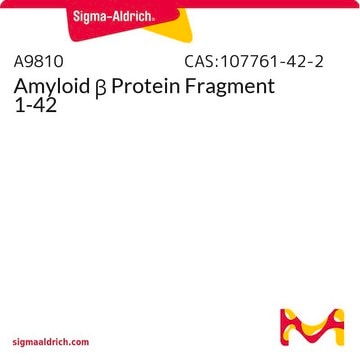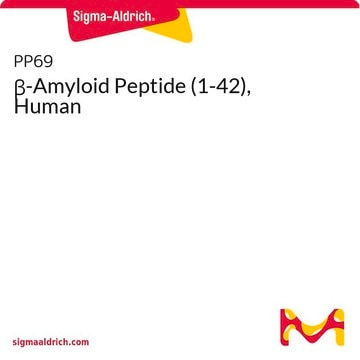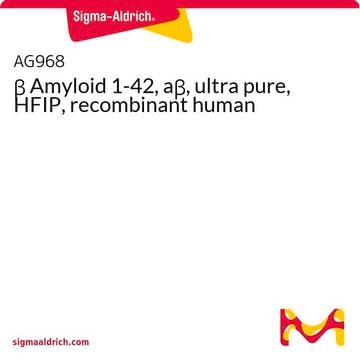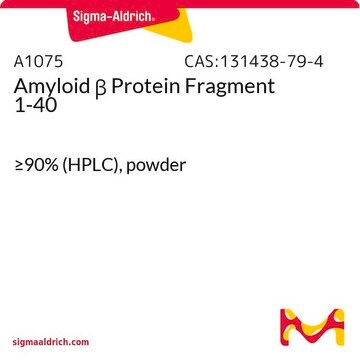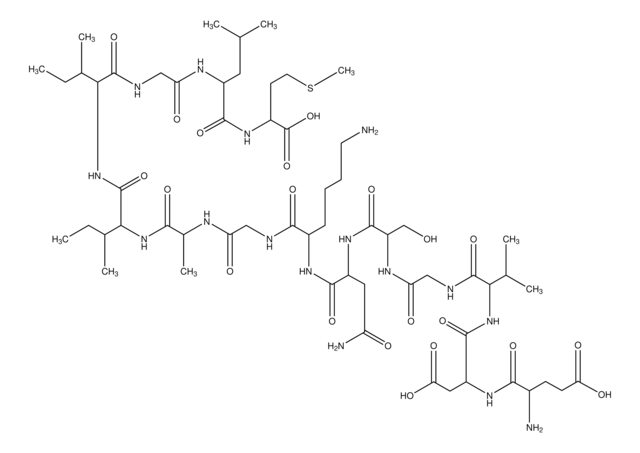Kluczowe dokumenty
A2201
Amyloid β-Protein Fragment 35-25
≥95% (HPLC)
Wybierz wielkość
657,00 zł
Wybierz wielkość
About This Item
657,00 zł
Polecane produkty
Poziom jakości
Próba
≥95% (HPLC)
Formularz
powder
numer dostępu UniProt
temp. przechowywania
−20°C
ciąg SMILES
CCC(C)C(NC(=O)CNC(=O)C(CC(C)C)NC(=O)C(N)CCSC)C(=O)NC(C(C)CC)C(=O)NC(C)C(=O)NCC(=O)NC(CCCCN)C(=O)NC(CC(N)=O)C(=O)NC(CO)C(=O)NCC(O)=O
InChI
1S/C45H81N13O14S/c1-9-24(5)36(57-34(62)20-50-40(67)29(17-23(3)4)54-39(66)27(47)14-16-73-8)45(72)58-37(25(6)10-2)44(71)52-26(7)38(65)49-19-33(61)53-28(13-11-12-15-46)42(69)55-30(18-32(48)60)43(70)56-31(22-59)41(68)51-21-35(63)64/h23-31,36-37,59H,9-22,46-47H2,1-8H3,(H2,48,60)(H,49,65)(H,50,67)(H,51,68)(H,52,71)(H,53,61)(H,54,66)(H,55,69)(H,56,70)(H,57,62)(H,58,72)(H,63,64)
Klucz InChI
IDGOADDOQWKZOX-UHFFFAOYSA-N
informacje o genach
human ... APP(351)
Amino Acid Sequence
Opis ogólny
Zastosowanie
Działania biochem./fizjol.
Inne uwagi
Kod klasy składowania
11 - Combustible Solids
Klasa zagrożenia wodnego (WGK)
WGK 3
Temperatura zapłonu (°F)
Not applicable
Temperatura zapłonu (°C)
Not applicable
Środki ochrony indywidualnej
Eyeshields, Gloves, type N95 (US)
Wybierz jedną z najnowszych wersji:
Masz już ten produkt?
Dokumenty związane z niedawno zakupionymi produktami zostały zamieszczone w Bibliotece dokumentów.
Klienci oglądali również te produkty
Active Filters
Nasz zespół naukowców ma doświadczenie we wszystkich obszarach badań, w tym w naukach przyrodniczych, materiałoznawstwie, syntezie chemicznej, chromatografii, analityce i wielu innych dziedzinach.
Skontaktuj się z zespołem ds. pomocy technicznej